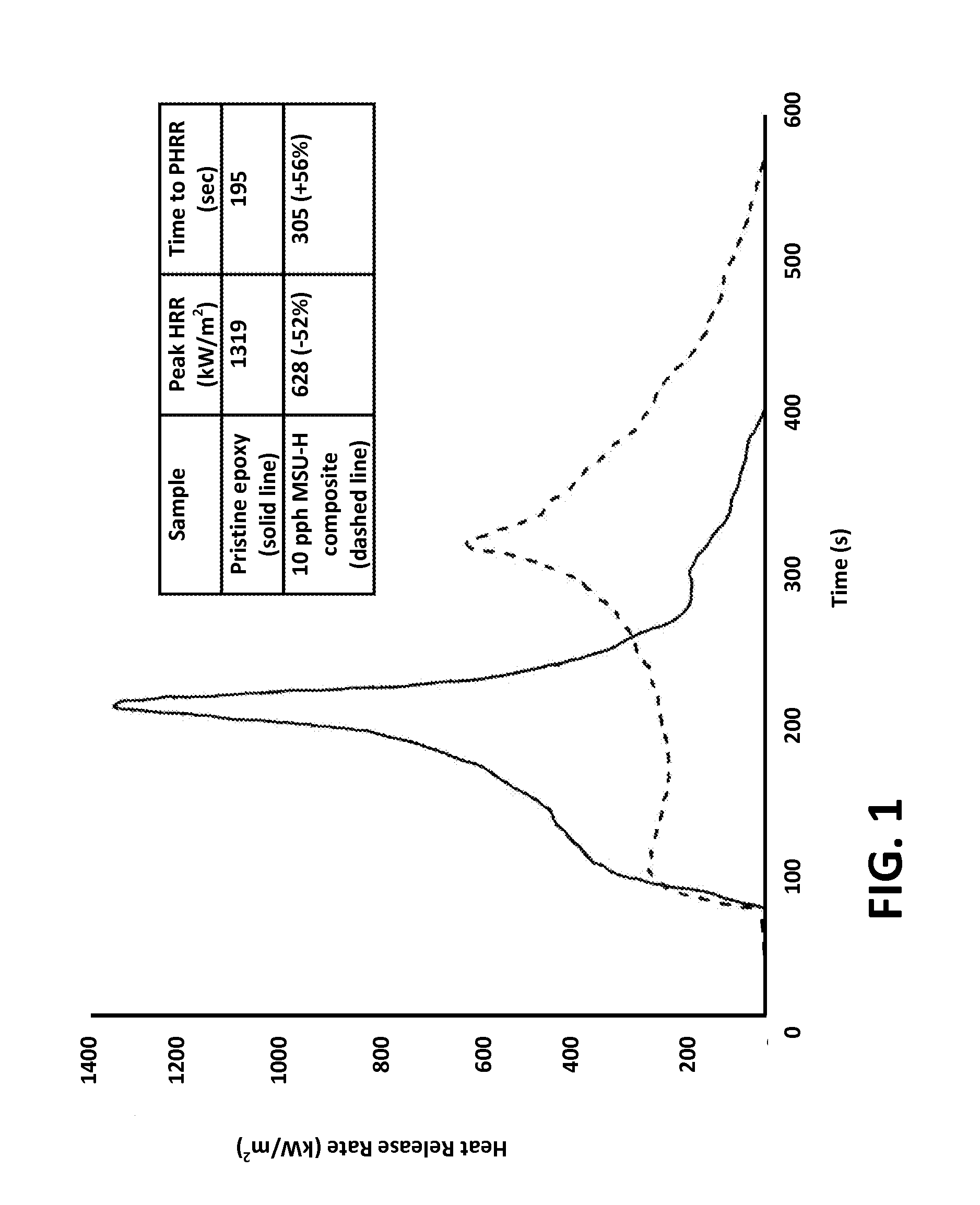Mesoporous Silicate Fire Retardant Compositions
a technology of mesoporous silicate and composition, which is applied in the direction of plastic/resin/waxes insulators, basic electric elements, electric apparatus, etc., can solve the problems of poor wetting properties, large processing cost of organoclay, and limitations of nano-clays, etc., to improve fire retardant properties, and improve the effect of fire retardant properties
- Summary
- Abstract
- Description
- Claims
- Application Information
AI Technical Summary
Benefits of technology
Problems solved by technology
Method used
Image
Examples
example 1
Epoxy-Mesoporous Silicate Composites
[0054]Cone calorimeter plaques were prepared as follows: a 76-gram quantity of epoxy polymer (Epon 826) was weighed into a plastic beaker. The beaker was placed in a 50° C. sand bath for 20 minutes. At the end of the 20 minutes, 5.0 or 10.0 grams of the desired mesoporous silicate additive was added and stirred-in by hand for 20 minutes. After stirring was completed, the composited polymer mixture was allowed to age in the 50° C. sand bath for one hour. The beaker containing the mixture was removed from the sand bath. Next, 24 grams of curing agent (Jeffamine D-230) were added and incorporated by hand stifling. Once incorporated, the mixture was stirred magnetically for 20 minutes. The mixture was then de-gassed under vacuum. Once de-gassed under vacuum at 50° C., the mixture was placed in silicone molds measuring 100 mm×100 mm×5 mm. The molds were pre-cleaned with ethyl alcohol and pre-treated with release agent (Mono-Coat E179). The specimens we...
example 2
Epoxy-Mesoporous Silicate-Urea Composites
[0068]Cone calorimeter plaques were prepared as follows: a 76-gram quantity of epoxy polymer (Epon 826) was weighed into a plastic beaker. The beaker was placed in a 50° C. sand bath for 20 minutes. At the end of the 20 minutes, mesoporous silicate and urea additives were added and stirred-in by hand for 20 minutes. After stifling was completed, the composite polymer mixture was allowed to age in the 50° C. sand bath for one hour. The beaker containing the mixture was removed from the sand bath. Next, 24 grams of curing agent (Jeffamine D-230) were added and incorporated by hand stifling. Once incorporated, the mixture was stirred magnetically for 20 minutes. The mixture was then de-gassed under vacuum. Once de-gassed under vacuum at 50° C., the mixture was placed in silicone molds measuring 100 mm×100 mm×5 mm. The molds were pre-cleaned with ethyl alcohol and pre-treated with release agent (Mono-Coat E179). The specimens were then cured for ...
example 3
Epoxy-Mesoporous Silicate-Ammonium Polyphosphate Composites
[0074]Cone calorimeter plaques were prepared as follows: a 76-gram quantity of epoxy polymer (Epon 826) was weighed into a plastic beaker. The beaker was placed in a 50° C. sand bath for 20 minutes. At the end of the 20 minutes, mesoporous silicate and Exolit 422 ammonium polyphosphate (Clariant) additives were added and stirred-in by hand for 20 minutes. After stirring was completed, the composited polymer mixture was allowed to age in the 50° C. sand bath for one hour. The beaker containing the mixture was removed from the sand bath. Next, 24 grams of curing agent (Jeffamine D-230) were added and incorporated by hand stirring. Once incorporated, the mixture was stirred magnetically for 20 minutes. The mixture was then de-gassed under vacuum. Once de-gassed under vacuum at 50° C., the mixture was placed in silicone molds measuring 100 mm×100 mm×5 mm. The molds were pre-cleaned with ethyl alcohol and pre-treated with release...
PUM
| Property | Measurement | Unit |
|---|---|---|
| diameter | aaaaa | aaaaa |
| diameter | aaaaa | aaaaa |
| length | aaaaa | aaaaa |
Abstract
Description
Claims
Application Information
 Login to View More
Login to View More - R&D
- Intellectual Property
- Life Sciences
- Materials
- Tech Scout
- Unparalleled Data Quality
- Higher Quality Content
- 60% Fewer Hallucinations
Browse by: Latest US Patents, China's latest patents, Technical Efficacy Thesaurus, Application Domain, Technology Topic, Popular Technical Reports.
© 2025 PatSnap. All rights reserved.Legal|Privacy policy|Modern Slavery Act Transparency Statement|Sitemap|About US| Contact US: help@patsnap.com

